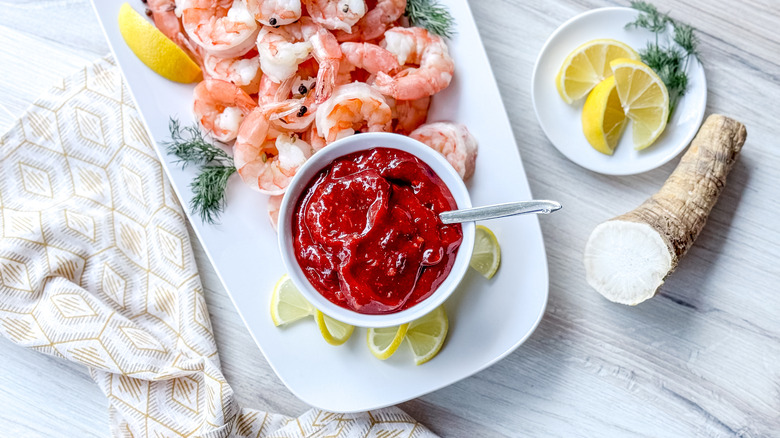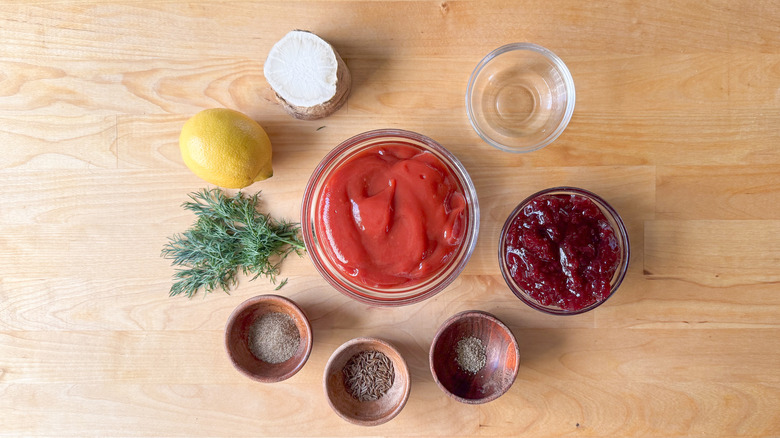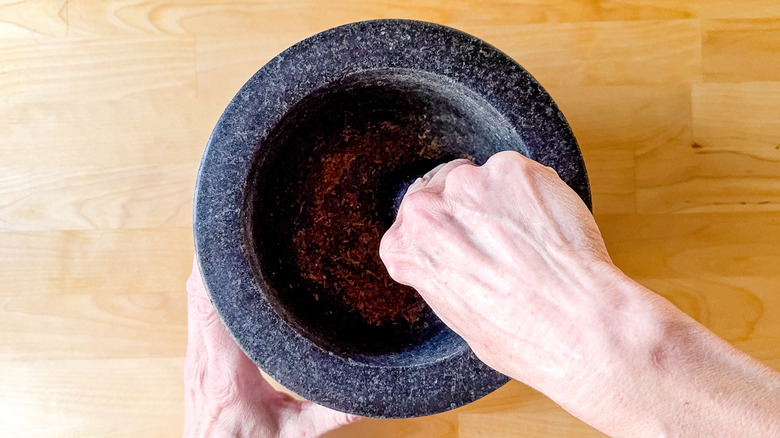Scandinavian-Inspired Lingonberry Cocktail Sauce Recipe
We may receive a commission on purchases made from links.
Classic shrimp cocktail sauce may be a prohibition era classic, but this pungent combination of horseradish and sweet ketchup traditionally seasoned with lemon juice, hot sauce, and a dash of Worcestershire remains the perfect pairing for chilled seafood to this day. Versions of the celebrated shrimp cocktail are found around the world in a variety of presentations, and recipe developer Julie Kinnaird brings us a taste of her own Swedish heritage with this festive Scandinavian-inspired lingonberry cocktail sauce.
Lingonberries grow naturally on evergreen bushes in Scandinavian forests, and, as such, they can be difficult to find. The tart berries can be used in everything from sweet desserts and beverages to game meat preparations. Lingonberries have a tart flavor similar to cranberries and are a delicious foil to sweeter ingredients, such as ketchup. To her cocktail sauce, Kinnaird adds in fresh dill, caraway seed, and even a bit of gin for a true Scandinavian taste. This sauce is not only delicious with chilled seafood but could be spread on an open-faced sandwich, slathered on a burger, used as a garnish for deviled eggs, or drizzled on roasted root vegetables.
Gather the Scandinavian-inspired lingonberry cocktail sauce ingredients
This easy-to-prepare yet wonderfully flavorful sauce comes together in mere minutes. You will start by peeling and grating some horseradish root to give the sauce a pungent and fresh flavor. Use a mortar and pestle to coarsely grind whole caraway seeds and bring out their essence to give the sauce a distinctively Scandinavian flair. Choose a good-quality ketchup as the base, checking the ingredients to make sure it does not contain high fructose corn syrup or an abundance of sweeteners. Lingonberry preserves add a distinctive sweet and tart quality with a bit of texture from the berries. Fresh dill and lemon juice add brightness and herbaceous undertones, while a splash of gin gives a bit of juniper notes. White pepper and celery salt give the sauce a final seasoning.
Step 1: Remove peel from the horseradish root
Remove the peel from the horseradish root.
Step 2: Grate the horseradish
Grate enough horseradish to measure 2 tablespoons. Set aside.
Step 3: Grind the caraway seeds
Use a mortar and pestle to grind the caraway seed into smaller pieces.
Step 4: Mix all ingredients
In a medium bowl, mix all ingredients until well-combined.
Step 5: Refrigerate the sauce
Transfer the sauce to a serving bowl and refrigerate until ready to use.
Step 6: Serve the sauce with your favorite foods
Use as a dip for cooked shrimp or other chilled seafood.
Scandinavian-Inspired Lingonberry Cocktail Sauce Recipe
This Scandinavian-inspired lingonberry cocktail sauce includes the tart berries, fresh horseradish, a splash of gin, fresh dill, and ketchup.

Ingredients
- 1 (2-inch) piece fresh horseradish root
- 1 teaspoon caraway seed
- 1 cup ketchup
- ½ cup lingonberry preserves
- 2 tablespoons fresh lemon juice
- 1 tablespoon chopped fresh dill
- 1 tablespoon gin
- 1 teaspoon celery salt
- ¼ teaspoon ground white pepper
Directions
- Remove the peel from the horseradish root.
- Grate enough horseradish to measure 2 tablespoons. Set aside.
- Use a mortar and pestle to grind the caraway seed into smaller pieces.
- In a medium bowl, mix all ingredients until well-combined.
- Transfer the sauce to a serving bowl and refrigerate until ready to use.
- Use as a dip for cooked shrimp or other chilled seafood.
Nutrition
| Calories per Serving | 26 |
| Total Fat | 0.0 g |
| Saturated Fat | 0.0 g |
| Trans Fat | 0.0 g |
| Cholesterol | 0.0 mg |
| Total Carbohydrates | 6.5 g |
| Dietary Fiber | 0.2 g |
| Total Sugars | 4.7 g |
| Sodium | 81.9 mg |
| Protein | 0.1 g |
What is the difference in taste between fresh and creamed horseradish?
Horseradish root comes, unsurprisingly, from the mustard family of plants. It has a characteristic tangy and spicy flavor and aroma that is enhanced once chopped or grated. When choosing fresh horseradish root from a grocery store, make sure it is firm and devoid of soft spots which could potentially harbor mold. Remove the tough outer peel and use a fine grater to shred the fibrous interior, taking care to avoid the more bitter core.
Prepared horseradish — AKA the creamy stuff you might find in the condiment aisle — has a more tempered flavor, as the freshly grated horseradish flesh is soaked in vinegar. This halts the enzymatic process in the root that produces the heat and spice, while still preserving the flavor. Creamed versions of prepared sauce may also contain sugar, egg, and other spices to balance the intensity of the root. Using freshly grated horseradish in recipes will give a distinct boldness of flavor, but also add a bitter edge. The prepared horseradish sauce should be used when you want a more subtle flavor in your finished product.
What are lingonberry preserves and can I use a different kind of preserves in this recipe?
If you have ever eaten the Swedish Fish candy, you have already been introduced to a hint of lingonberry flavor. Lingonberries are often confused with cranberries for their similar crimson hue, hardy skins, and tart tang. Lingonberries typically grow wild in parts of the Northern hemisphere and are foraged in the late summer months when they are at their most ripe. Lingonberries have a long culinary history in Scandinavia and other cultures across Northern Europe, and they've even become quite popular in the U.S. thanks to IKEA, which serves a lingonberry sauce with its ever popular Swedish meatball plate.
Lingonberries are also something of a superfruit, as they are high in antioxidants and can help lower inflammation. Unlike cranberries, lingonberries are sometimes eaten fresh but they are best tamed with a bit of sugar, and are most commonly found in the form of preserves. Sweetened lingonberries can be used in pastries and deserts, but also play a role in savory dishes. If you can't find lingonberry preserves for this cocktail sauce recipe, try substituting in a bit of cranberry sauce or tart cherry jam. You may want to add some extra lemon juice if the cocktail sauce ends up tasting too sweet.










